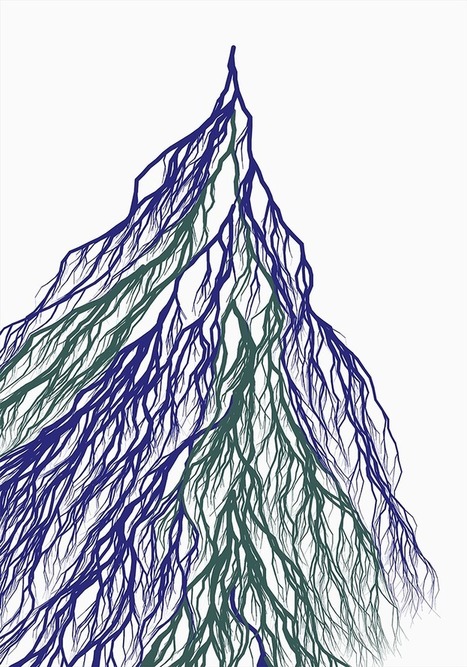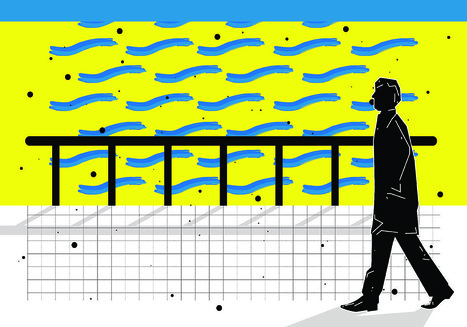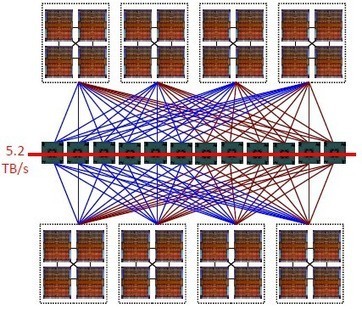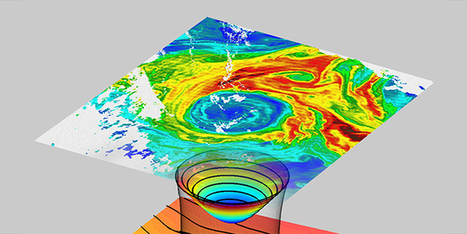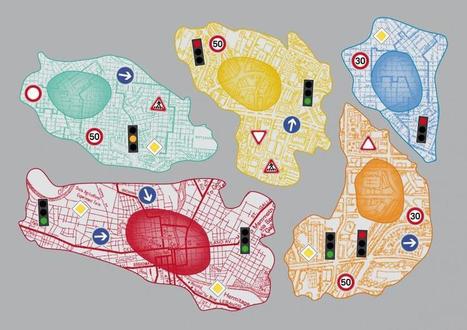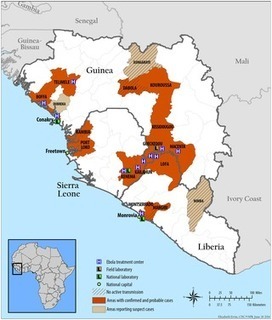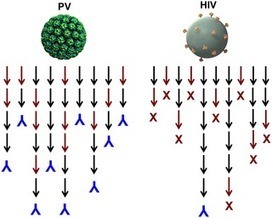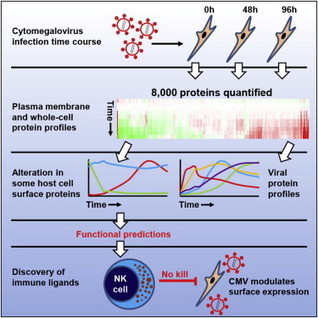 Your new post is loading...
 Your new post is loading...
John H. Holland's general theories of adaptive processes apply across biological, cognitive, social, and computational systems.
Here’s how to cause a ruckus: Ask a bunch of naturalists to simplify the world. We usually think in terms of a web of complicated…
Nature’s large-scale patterns emerge from incomplete surveys, thanks to ideas borrowed from information theory.
Where do a zebra’s stripes, a leopard’s spots and our fingers come from? The key was found years ago – by the man who cracked the Enigma code, writes Kat Arney.
The annual estimates reflect amounts that change as a result of science, actual research projects funded, and the NIH budget. The research categories are not mutually exclusive. Individual research projects can be included in multiple categories so amounts depicted within each column of this table do not add up to 100 percent of NIH-funded research. The table shows historical data for FY 2010 through FY 2013. The FY 2014-2015 estimates are based on RCDC actual data.
As humans transform ecosystems and come into closer contact with animals, scientists fear more viral epidemics
Our bodies are a genetic patchwork, possessing variation from cell to cell. Is that a good thing?
Say what you will about Oracle co-founder and CEO Larry Ellison, but when the software giant bought Sun Microsystems more than four years ago, for $7.4 bil
Food Safety News How CDC Uses Antibiotic Resistance Data Food Safety News Over the past year, you may have noticed that antimicrobial resistance information has been incorporated in the outbreak reports put out by the Centers for Disease Control...
An indispensable part of our personal and working lives, computing has also become essential to industries and governments. Steady improvements in computer hardware have been supported by periodic doubling of transistor densities in integrated circuits over the past fifty years. Such Moore scaling now requires ever-increasing efforts, stimulating research in alternative hardware and stirring controversy. To help evaluate emerging technologies and increase our understanding of integrated-circuit scaling, here I review fundamental limits to computation in the areas of manufacturing, energy, physical space, design and verification effort, and algorithms. To outline what is achievable in principle and in practice, I recapitulate how some limits were circumvented, and compare loose and tight limits. Engineering difficulties encountered by emerging technologies may indicate yet unknown limits. Limits on fundamental limits to computation
Igor L. Markov
Nature 512, 147–154 (14 August 2014) http://dx.doi.org/10.1038/nature13570
Via Complexity Digest
Enormous vortices of water, measuring 60 miles across, spin their way across the sea at a deliberate pace---3 miles per day.
Cells regulate the uptake of nutrients and messenger cargos and their transport within the cell. This process is known as endocytosis and membrane traffic. Different cargos dock onto substrate specific receptors on the cell membrane. Special proteins such as kinases, GTPases and coats, activate specific entry routes and trigger the uptake of the receptors into the cell. For their uptake, the receptors and docked cargos become enclosed by the cell membrane. In the next steps, the membrane invaginates and becomes constricted. The resulting vesicle is guided via several distinct stations, cellular organelles, to its final destination in the cell. For her study, Dr. Prisca Liberali, senior scientist in the team of Professor Lucas Pelkmans, sequentially switched off 1200 human genes. Using automated high-throughput light microscopy and computer vision, she could monitor and compare 13 distinct transport paths involving distinct receptors and cellular organelles. Precise quantifications of thousands of single cells identified the genes required for the different transport routes. Surprisingly, sets of transport routes are co-regulated and coordinated in specific ways by different programs of regulatory control. Subsequently, Dr. Liberali calculated the hierarchical order within the genetic network and thereby identified the regulatory topology of cellular transport. "The transport into the cell and within the cells proceeds analogously to the cargo transport within a city" describes the scientist. "Like in a city, the traffic on the routes within a cell and their intersections is tightly regulated by traffic lights and signs to guide the cargo flow." Thanks to this unique quantitative map, the fine regulatory details of transport paths and processes within a cells could be mapped for the first time. Particularly the genes that encode for these traffic lights and switches are often de-regulated in disease. With this map, it is now possible to predict how this leads to traffic jams in the cells, causing the disease phenotype. Alternatively, since many drugs have been developed to target these traffic lights and switches, the map can be used to come up with possible drug combinations to target unwanted traffic, such as viruses, to the waste disposal system of the cell.
Via Dr. Stefan Gruenwald, burkesquires
|
Complex systems may have billion components making consensus formation slow and difficult. Recently several overlapping stories emerged from various disciplines, including protein structures, neuroscience and social networks, showing that fast responses to known stimuli involve a network core of few, strongly connected nodes. In unexpected situations the core may fail to provide a coherent response, thus the stimulus propagates to the periphery of the network. Here the final response is determined by a large number of weakly connected nodes mobilizing the collective memory and opinion, i.e. the slow democracy exercising the 'wisdom of crowds'. This mechanism resembles to Kahneman's "Thinking, Fast and Slow" discriminating fast, pattern-based and slow, contemplative decision making. The generality of the response also shows that democracy is neither only a moral stance nor only a decision making technique, but a very efficient general learning strategy developed by complex systems during evolution. The duality of fast core and slow majority may increase our understanding of metabolic, signaling, ecosystem, swarming or market processes, as well as may help to construct novel methods to explore unusual network responses, deep-learning neural network structures and core-periphery targeting drug design strategies. Fast and slow thinking -- of networks: The complementary 'elite' and 'wisdom of crowds' of amino acid, neuronal and social networks
Peter Csermely http://arxiv.org/abs/1511.01238 ;
Via Complexity Digest
A potent theory has emerged explaining a mysterious statistical law that arises throughout physics and mathematics.
Growing nerve tissue and organs is a sci-fi dream. Moheb Costandi met the pioneering researcher who grew eyes and brain cells.
The precise factors that result in an Ebola virus outbreak remain unknown, but a broad examination of the complex and interwoven ecology and socioeconomics may help us better understand what has already happened and be on the lookout for what might happen next, including determining regions and populations at risk. Although the focus is often on the rapidity and efficacy of the short-term international response, attention to these admittedly challenging underlying factors will be required for long-term prevention and control.
To determine geographic range for Ebola virus, we tested 276 bats in Bangladesh. Five (3.5%) bats were positive for antibodies against Ebola Zaire and Reston viruses; no virus was detected by PCR. These bats might be a reservoir for Ebola or Ebola-like viruses, and extend the range of filoviruses to mainland Asia.
The NVIDIA® CUDA® Toolkit provides a comprehensive development environment for C and C++ developers building GPU-accelerated applications. The CUDA Toolkit includes a compiler for NVIDIA GPUs, math libraries, and tools for debugging and optimizing the performance of your applications.
A couple months back, Mark Buchannan wrote an article in which he argued that ABMs might be a productive way of trying to understand the economy. In fact, he went a bit further – he said that ABMs...
From molecules to physiology
ALIFE 14, the Fourteenth International Conference on the Synthesis and Simulation of Living Systems, presents the current state of the art of Artificial Life—the highly interdisciplinary research area on artificially constructed living systems, including mathematical, computational, robotic, and biochemical ones. The understanding and application of such generalized forms of life, or “life as it could be,” have been producing significant contributions to various fields of science and engineering.
This volume contains papers that were accepted through rigorous peer reviews for presentations at the ALIFE 14 conference. The topics covered in this volume include: Evolutionary Dynamics; Artificial Evolutionary Ecosystems; Robot and Agent Behavior; Soft Robotics and Morphologies; Collective Robotics; Collective Behaviors; Social Dynamics and Evolution; Boolean Networks, Neural Networks and Machine Learning; Artificial Chemistries, Cellular Automata and Self-Organizing Systems; In-Vitro and In-Vivo Systems; Evolutionary Art, Philosophy and Entertainment; and Methodologies. Artificial Life 14 Proceedings of the Fourteenth International Conference on the Synthesis and Simulation of Living Systems Edited by Hiroki Sayama, John Rieffel, Sebastian Risi, René Doursat and Hod Lipson http://mitpress.mit.edu/books/artificial-life-14
Via Complexity Digest
A systematic quantitative analysis of temporal changes in host and viral proteins throughout the course of a productive infection could provide dynamic insights into virus-host interaction. We developed a proteomic technique called “quantitative temporal viromics” (QTV), which employs multiplexed tandem-mass-tag-based mass spectrometry. Human cytomegalovirus (HCMV) is not only an important pathogen but a paradigm of viral immune evasion. QTV detailed how HCMV orchestrates the expression of >8,000 cellular proteins, including 1,200 cell-surface proteins to manipulate signaling pathways and counterintrinsic, innate, and adaptive immune defenses. QTV predicted natural killer and T cell ligands, as well as 29 viral proteins present at the cell surface, potential therapeutic targets. Temporal profiles of >80% of HCMV canonical genes and 14 noncanonical HCMV open reading frames were defined. QTV is a powerful method that can yield important insights into viral infection and is applicable to any virus with a robust in vitro model.
Via burkesquires
Community Resource for the VIZBI conference series on computer methods for visualizing biological data, including genomes, protein sequences, phylogenies, macromolecular structures, systems biology, microscopy, and magnetic resonance imaging.
|
 Your new post is loading...
Your new post is loading...
 Your new post is loading...
Your new post is loading...








